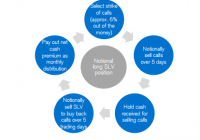The Fed And SLV – What’s Ahead?
Summary The FOMC is expected to raise rates this week. How will this decision impact SLV? Whether the Fed raises rates or not, isn’t the only issue to consider. The FOMC is expected to convene this week and decide whether it’s time to hit lift off and raise rates. While rates are still expected to remain low, even a modest hike of 0.25 basis points could be enough to send down the iShares Silver Trust ETF (NYSEARCA: SLV ). But the direction of the silver market won’t only rely on the whether the Fed raises rates or not. Other considerations also matter including what’s the trajectory of the future rate hikes, the wording of the statement, the revised outlook for next year, and Chair Yellen’s press conference just to name a few. How will the Fed expected hike move the price of SLV? Let’s breakdown what’s up ahead for SLV. Based on the implied probabilities , the market expects three rate hikes in 2015-2016 with a very likely hike in December – a little over 80% chance, the highest level in months. But with an 80% chance this still gives some room for uncertainty in the markets. (click to enlarge) Source: Fed-watch If the Fed does move along with the hike, it’s likely to bring down the price of SLV as it did back in the last FOMC meeting when the Fed stated it’s ready to raise rates in December. Is the market ready for a hike? When it comes to the reasoning for raising rates the Fed sees that the U.S. labor market is on course to full employment with unemployment rate at 5%, an average of over 200,000 jobs were added a monthly basis in 2015 and wage growth at 2.3%. Also, U.S. core CPI is at 1.9%, which isn’t far off the Fed’s 2% target . And the Case-Shiller home price index showed that prices have been steadily climbing in the past three years; while prices aren’t at record high levels of mid-2006, they are still high enough to sustain a rise in mortgage rates and weed out any possible bubbles that may be forming in the real estate market. The same could be said about the stock market. The flip side for keeping rates unchanged is that the labor market may not be in a good enough shape to sustain higher rates with “real unemployment rate” or U6 rate is close to 10% and participation rate remains low. Moreover, the expected rising cash rates will make it even harder for the Fed to reach its 2% inflation goal. And low commodities prices aren’t helping. Having said that, the Fed is still expected to raise rates this meeting. And higher rates won’t do any good for SLV. From the perceptive of the stronger U.S. dollar, a stronger dollar could push down SLV. After all, the rally of the U.S. dollar in recent weeks, up to the last couple of weeks, seemed to have contributed to the weakness of SLV, as indicated in the chart below. (click to enlarge) Source: FRED and Google finance Bear in mind, however, that the correlation between the two isn’t too strong at -0.26 during 2015. But the correlation has intensified lately: Over the past couple of months it reached -0.4. So keep an eye out for the direction of U.S. dollar, which is likely to keep rising if the Fed moves on with normalization. Beyond this time’s rate hike Looking beyond the expected rate hike, the Fed is likely to issue a statement with a dovish tone reiterating that future hikes won’t be every other meeting and will spread apart in 2016 – something that will be backed by the dot plot. Chair Yellen will also try to calm the markets by assuring the strength and stability of the U.S. economy and how another hike won’t be decided any time soon (the term “data dependent” will be thrown a lot – as it always is). The FOMC will also release its dot plot about the cash rate. Back in September, the FOMC anticipated rates will rise to 1.4% by the end of next year and 2.6% by the end of 2017. The trajectory of the cash rate could also have an impact on the direction of the price of SLV. On this issue, if the FOMC were to revise down its outlook about the cash rates, and it’s a very likely scenario, this could partly offset the adverse impact the rate hike in the upcoming meeting will have on precious metals prices. This could translate to keeping SLV from tumbling down in the coming months. Unless the Fed surprises the market, the short term outlook of SLV is still likely to be downward. The expected rise in the U.S. dollar could keep driving down SLV. On the other hand, if the Fed cuts down again its outlook for the cash rate in 2016 and beyond, this could, down the line, keep the price of SLV from further plunging in the medium term. For more please see: Will Higher Physical Demand for Silver Drive Up SLV?
